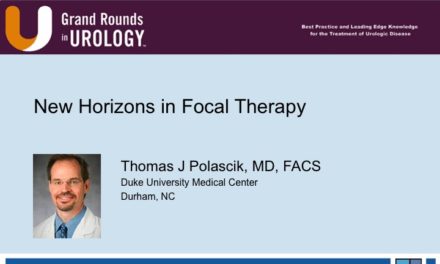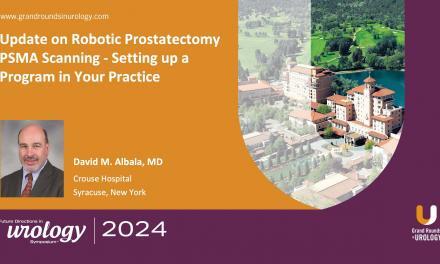Brian J. Moran, MD, presented “Contemporary Brachytherapy: A View from the ABS” during the 31st International Prostate Cancer Update in July 2021 in Snowbird, Utah.
How to cite: Moran, Brian J. “Contemporary Brachytherapy: A View from the ABS.” July 2021. Accessed May 2025. https://grandroundsinurology.com/contemporary-brachytherapy-a-view-from-the-abs/
Contemporary Brachytherapy: A View from the ABS – Summary
Brian J. Moran, MD, the Medical Director for the Chicago Prostate Cancer Center and the Director of Radiation Oncology at DuPage Medical Group, outlines how improved diagnostics have led to better-targeted brachytherapy treatment for localized prostate cancer. He begins by asserting that the debate is over—low-dose rate (LDR)/high-dose rate (HDR) brachytherapy is an effective treatment for localized prostate cancer, and he argues that the focus should shift to innovative brachytherapy techniques. Dr. Moran explains that improved diagnostics such as MRI and fusion biopsy, transperineal mapping biopsy, and genomic analysis allow urologists to better differentiate cancer types and better understand risk groups. He then presents the American Brachytherapy Society guidelines for various treatment groups. Despite this, Dr. Moran cites a decline in the use of brachytherapy due to competing treatments such as robotic surgery, intensity-modulated radiation therapy (IMRT), and proton therapy and due to low active brachytherapy volumes in most training programs in the United States. Dr. Moran says there is robust patient demand for brachytherapy because it offers patients a single-treatment option vs. nine weeks of external-beam radiation therapy (EBRT) or surgery, producing excellent patient outcomes while maintaining quality of life. Dr. Moran differentiates LDR and HDR brachytherapy and then reiterates the importance of urologists being able to understand the precise location of a malignancy and to target therapy to that location, highlighting a book, Focal Therapy in Prostate Cancer. Dr. Moran expounds on this notion by contrasting transperineal prostate mapping biopsy (TRPB) with stereotactic transperineal prostate biopsy (STPB), asserting that, unlike TRPB, STPB allows doctors to map the precise location of the samples taken. Dr. Moran then outlines methods of focal brachytherapy and identifies which patients are candidates for it, including those with low-risk, low-volume disease; intermediate-risk, low-volume disease; and high-risk, low-volume disease, provided it was accurately identified. Dr. Moran asserts it would be irresponsible for urologists not to explore brachytherapy, citing patient demand, low cost, and efficacy. He concludes by addressing recurrence and treatment options for previously-treated focal brachytherapy patients who may develop a new cancer.
About The 31st Annual International Prostate Cancer Update:
The International Prostate Cancer Update (IPCU), founded in 1990, is a multi-day CME conference focused on prostate cancer treatment updates with expert, international faculty. It is led by expert physicians and is designed for urologists, medical oncologists, radiation oncologists, and other healthcare professionals involved in the diagnosis and treatment of prostate cancer. Dr. Moran delivered this educational activity during the 31st iteration of the meeting in July 2021 in Snowbird, Utah.
ABOUT THE AUTHOR
Brian J. Moran, MD, was the Medical Director of the Chicago Prostate Cancer Center, which he helped found in 1997. He was also the Director of Radiation Oncology at Duly Health and Care. He performed prostate seed implants since 1994. Dr. Moran graduated from the of Loyola Stritch School of Medicine, where he also completed his residency. He was board-certified by the American Board of Radiology. An experienced practitioner of prostate brachytherapy, Dr. Moran performed thousands of prostate seed implants and proctored physicians all over the United States and the world, including in Korea, Europe, and Hong Kong. Dr. Moran was a member of multiple specialty societies, including the American Society of Therapeutic Radiology and Oncology, the American College of Radiology, and the American Brachytherapy Society. Dr. Moran placed an emphasis on quality of life issues and long-term outcomes for prostate cancer patients. His passion for these issues was evident Dr. Moran was a frequent speaker at professional meetings, and authored numerous publications in medical journals and textbooks.





